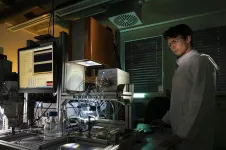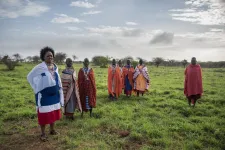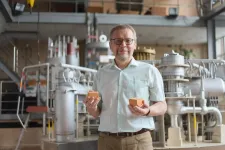(Press-News.org) Over 20 Indonesian islands mysteriously disappear. One of the world's deadliest criminal syndicates rises to power. Eight cities the size of New York will be built every year for the next three decades. What connects them is sand, embedded in the concrete of nearly all of the world's buildings, roads, and cities, the glass in the windows, laptops and phone screens, and COVID-19 vaccine vials.
The unexamined true costs of sand - broadly, construction aggregates production -- has spurred a group of scientists to call for a stronger focus on understanding the physical dimension of sand use and extraction. They also suggest new ways to achieve economic and environmental justice.
Four years ago, an international group of scientists, including two from Michigan State University (MSU), called attention to a looming global sand crisis. Extraction of valuable resources across the planet typically brings to mind oil, coal or rare earth minerals. Construction aggregates - sand, gravel and crushed rock - can seem less rare by comparison. It's easy, after all, to find a vast sandy beach, gravel pit or local hard rock quarry. However, construction aggregates are critical for meeting society's needs for housing, health, energy, transportation, and industry.
In Science Magazine in September 2017, the group noted that overexploitation of sand, a key ingredient of concrete, asphalt and glass, was damaging the environment, endangering communities, and triggering social conflicts.
In this week's One Earth, scientists led by research associate Aurora Torres shine a new light on the sustainability implications of the world's hunger for sand and propose different solutions for meeting these challenges.
"With this paper, we look forward towards what we need to do as a society if we want to promote a sustainable consumption on global sand resources," said Torres, part of MSU's Center for Systems Integration and Sustainability (CSIS) and the Université catholique de Louvain in Belgium. "A drastic problem calls for drastic solutions - truly doing this differently to put aside problems and create pathways to sustainability."
The authors of "Sustainability of the global sand system in the Anthropocene" call for a new way of looking at and understanding the interlinkages of sand supply and demand to reduce negative impacts such as depleting natural environments and creating human conflict. Collaborating across the research disciplines made it possible to fit the puzzle pieces into a full picture. Rather than focusing on single sand extraction sites like many studies before them, they take a broad look at the physical and socio-environmental dimensions of sand supply networks - linking extraction, processing, distribution, economics, policy - to gain an in-depth understanding of the stresses on both nature and people.
The novelty of the sand supply network approach is the integration of material flow analysis with the telecoupling framework to provide a more robust and holistic perspective on the sand system across different spatio-temporal scales. It allows for understanding and quantifying socioeconomic and environmental interactions from mining sites to consumption sites, such as cities, and spillover systems such as the transport corridors or rural landfills where the mining and construction waste piles up.
"Simple views cannot solve complex sustainability challenges," said co-author Jianguo "Jack" Liu, director of MSU-CSIS. "New ways like the telecoupling framework help untangle and embrace the complexity of global sand challenges and point the way toward effective solutions."
In addition, the authors highlight that robust strategies for managing sand resources depend on a solid understanding of the construction aggregates cycle. As Mark Simoni from the Geological Survey of Norway put it, "the physical system is key for linking local impacts of natural resource extraction to global development trends -- we have to map how construction material demand and supply evolve over space and time to inform stakeholder decisions and policymaking."
This requires quantifying the geological deposits, flows, and accumulation of construction aggregates within a region, including both natural raw material sources and alternatives, and it can be used to assess how long resources will last and how the entire supply system can be optimized to reduce negative impacts of sand mining and make use of substitute materials.
For example, they said, we need to think about construction aggregates beyond excavating deposits of sand and gravel. Blasting and crushing rocks also produces 'artificial' sand and gravel of similar or even higher quality and is a major export commodity for instance for Norway. Indeed, crushed rock has already become the main source of aggregates in countries like the U.S., China or in Europe.
With demand for construction aggregates predicted to double in the next decades, the sustainability challenge is daunting. Understanding how sand-supply networks work is relevant not only for assessing their full impacts but also for identifying leverage points for sustainability.
"As with climate change, there is not a single solution but multiple entry points for more sustainable consumption," Torres said. Possible pathways include reducing material demand per capita, promoting compact urban development for more efficient material use, reducing reliance on natural deposits by developing the market and technologies for secondary materials such as construction and demolition waste, and when mining natural deposits is necessary, identifying the mining sources and production methods that minimize impacts for nature and people.
INFORMATION:
In addition to Torres and Liu, the paper was written by Mark Simoni and Daniel B. Müller of the Norwegian University of Science and Technology in Trondheim, Norway; Jakob Keiding of the Geological Survey of Denmark and Greenland in København, Denmark; Sophus zu Ermgassen of the University of Kent in Canterbury, UK; Jochen Jaeger of Concordia University in Montreal, Canada; Marten Winter at the German Centre for Integrative Biodiversity Research in Leipzig, Germany; and Eric F. Lambin at Stanford University in Stanford, CA.
The work was funded by the European Union's Horizon 2020 research and innovation program under the Marie Sklodowska-Curie grant agreement (846474) through the SANDLINKS project.
What The Study Did: Medication use among hospitalized patients for COVID-19-related treatment in a large university health care system was examined in this study.
Authors: Jonathan H. Watanabe, Pharm.D., Ph.D., of the University of California, Irvine, School of Pharmacy & Pharmaceutical Sciences, is the corresponding author.
To access the embargoed study: Visit our For The Media website at this link https://media.jamanetwork.com/
(doi:10.1001/jamanetworkopen.2021.10775)
Editor's Note: Please see the article for additional information, including other authors, author contributions and affiliations, conflict of interest and financial disclosures, and funding and support.
INFORMATION:
Media advisory: ...
What The Study Did: Oregon's Reproductive Health Equity Act ensured coverage for family planning (abortion and contraception) using state funds for all low-income state residents regardless of citizenship status. Researchers in this study describe the first two years of abortion services covered and the distances traveled by women to receive care.
Authors: Maria I. Rodriguez, M.D., M.P.H., of Oregon Health & Science University in Portland, is the corresponding author.
To access the embargoed study: Visit our For The Media website at this link https://media.jamanetwork.com/
(doi:10.1001/jamahealthforum.2021.0402)
Editor's ...
What The Study Did: Variation in SARS-CoV-2 infection risk and socioeconomic disadvantage among a Mayan-Latinx population in Fruitvale, California, was examined in this study.
Authors: Paul Wesson, Ph.D., of the University of California, San Francisco, is the corresponding author.
To access the embargoed study: Visit our For The Media website at this link https://media.jamanetwork.com/
(doi:10.1001/jamanetworkopen.2021.10789)
Editor's Note: The article includes conflict of interest and funding/support disclosures. Please see the article for additional information, including other authors, author contributions and affiliations, ...
What The Study Did: This observational study found no association between long-term dietary intake of gluten and cognitive function among a large group of middle-age women without celiac disease.
Authors: Andrew T. Chan, M.D., M.P.H., of Massachusetts General Hospital and Harvard Medical School in Boston, is the corresponding author.
To access the embargoed study: Visit our For The Media website at this link https://media.jamanetwork.com/
(doi:10.1001/jamanetworkopen.2021.13020)
Editor's Note: The article includes conflict of interest and funding/support disclosures. Please see the article for additional information, including other authors, author contributions and affiliations, conflict of interest and financial disclosures, and funding and support.
# ...
One trait shared by all humans is that they don't remember specific life episodes that occurred before the age of 3 or 4. Many scientists have attributed this so-called "infantile amnesia" to a lack of development in the hippocampus, an area of the brain located in the temporal lobe that is crucial to encoding memory.
However, a new brain imaging study by Yale scientists shows that infants as young as three months are already enlisting the hippocampus to recognize and learn patterns. The findings were published May 21 in the journal Current Biology.
"A fundamental mystery ...
Irvine, Calif. - A record of medicine utilization patterns assembled by an interdisciplinary team of researchers at the University of California, Irvine and the UC San Diego School of Medicine reveals the thought, care and scientific rigor clinicians at UC Health medical centers applied in their treatment of patients with COVID-19 in 2020.
For a study published today in Journal of the American Medical Association Network Open, the investigators examined data on the usage rates of 10 different medicines and medicine categories to map how drugs were used on people hospitalized with the viral infection.
The authors got their data ...
Micropollutants such as steroid hormones contaminate drinking water worldwide and pose a significant threat to human health and the environment even in smallest quantities. Until now, easily scalable water treatment technologies that remove them efficiently and sustainably have been lacking. Scientists at the Karlsruhe Institute of Technology (KIT) developed a new chemical process for removing hormones. It takes advantage of the mechanisms of photocatalysis and transforms the pollutants into potentially safe oxidation products. The team reports on this in the scientific ...
The findings of a clinical trial by Trinity College Dublin researchers of treatment for atopic dermatitis have been published today in The Lancet journal (Friday, 21st May, 2021). Results of the clinical trial at the School of Medicine, Trinity College and St James's Hospital, Dublin have shown the drug upadacitinib to be the most effective treatment to date for this chronic, relapsing inflammatory condition. The research is vital as there is an unmet need which exists for therapies that provide remission of symptoms in moderate-to-severe atopic dermatitis.
The publication reports efficacy and safety results of upadacitinib compared with placebo for the treatment of moderate-to-severe atopic dermatitis in adults and adolescents. This pivotal Global Phase ...
An international study led by the ICTA-UAB states that recognizing indigenous peoples' and local communities' rights and agency is critical to addressing the current biodiversity crisis
Policies established by the post-2020 Global Biodiversity Framework of the Convention on Biological Diversity (CBD) could be ineffective if the rights and agency of indigenous peoples and local communities are not recognized and fully incorporated into biodiversity management. This is supported by an international study led by the Institute of Environmental Science and Technology of the Universitat Autònoma de Barcelona (ICTA-UAB) and recently published in the journal Ambio.
The ...
Scientists at the Ural Federal University (UrFU, Russia) have created clay bricks that are able to attenuate ionizing radiation to a level that is safe for the human body. To the composition of bricks scientists add waste from the industry, which protects against radiation. The article describing the technology was published in the journal Applied Radiation and Isotopes.
"Bricks are a relatively cheap and convenient material with which we can quickly erect protective rooms, structures, walls around objects with radiation," says scientific head of the project, associate professor of the Department of Nuclear Power Plants and Renewable Energy Sources at UrFU Oleg Tashlykov. "The bricks ...




